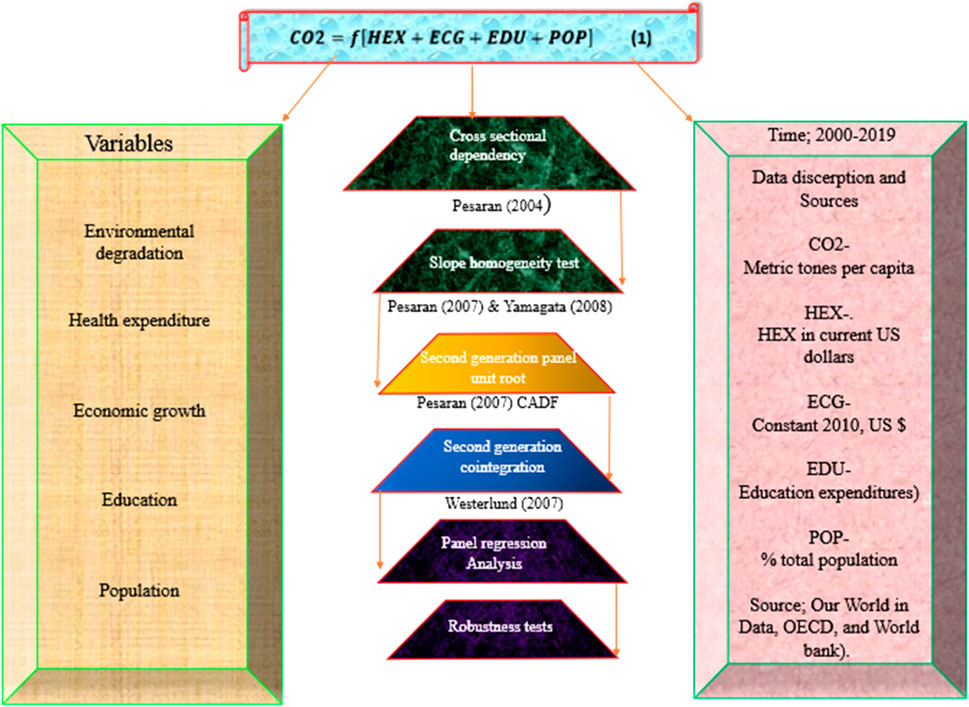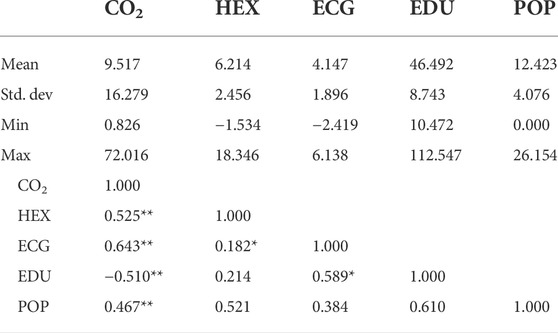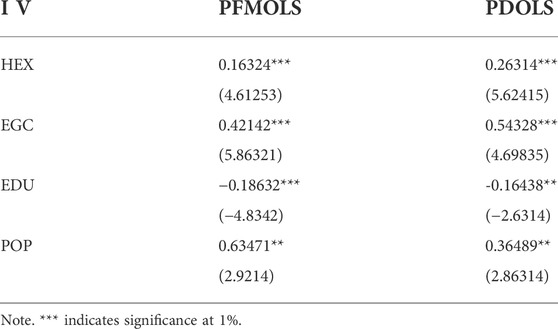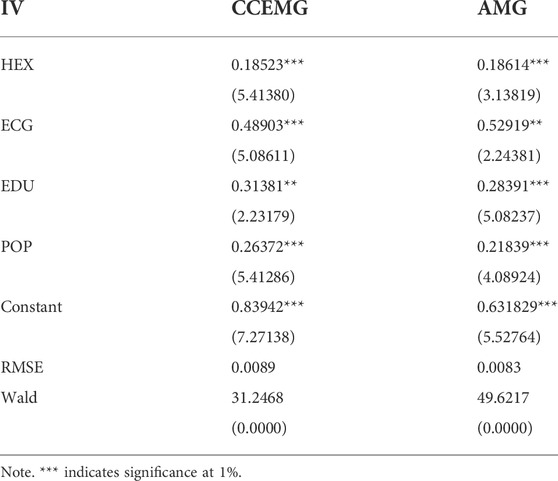- 1School of Sports Science and Physical Education, Nanjing Normal University, Nanjing, China
- 2School of Management, Jiangsu University, Zhenjiang, Jiangsu, China
Physical education benefits health and the environment because the world takes long-term steps to stop environmental degradation and its effects. Therefore, the present study examined the impact of health expenditure, education, economic growth, and population on environmental degradation in seven emerging economies from 2000 to 2019. The cross-sectional dependency (CSD) reflected the panel nations’ CSD, whereas the second-generation panel unit root test confirmed all indicators’ stationarity at first difference. Thus, the second-generation cointegration approach identified a long-term equation among the CO2, health expenditure, education, economic growth and population. The long-run empirical estimations derived from the PFMLOS and PDOLS method emphasized that education increases the region’s environmental sustainability and decreases CO2 emissions. Conversely, health expenditure, economic growth, and population increase CO2 emissions and reduce environmental quality in the E-7 bloc. Moreover, our findings are resilient to alternative measures by AMG and CCEMG, which might help policymakers develop long- and short-term initiatives for environmental protection. The study suggests adopting physical education and physical health activities to curb environmental degradation in the panel region.
1 Introduction
Social policy concerns environmental protection, education, mental and physical health. People’s life has changed tremendously since COVID-19 began. Open spaces, restaurants, and sports facilities were closed to manage the infection. People were urged to stay home and maintain social distance, organizations were forced to reduce operating hours or lay off personnel, and educational institutions began offering online courses. Physical inactivity is a major public health concern in most world areas. It won't be solved by organized sports or leisure-time activity alone. The influence of these changes in lifestyle on psychological aspects such as physical education, physical health, and climate raises concerns. The relationship between health expenditure (HEX), education (EDU), economic growth (ECG), population (POP) and environmental degradation (CO2) has gained significant attention in both emerging and developed countries during the past 2 decades. These interactions between health expenditure, education, economic growth and population on environmental deterioration are complex and important.
Carbon emissions were chosen as one of the main factors since they are a significant contributor to environmental deterioration and the causes of falling health standards. Global energy usage and the related generation of greenhouse gases, mainly carbon dioxide, are key contributors to climate change (Figure 1). Major emitting nations pledged to limit the adverse impacts of growing carbon emissions in the November 2016 Paris Agreement. The aims to decrease global temperatures to 1.5°C levels (Jianguo et al., 2022). The “BP Statistical Yearbook of International Renewable Energy Agency (2021),” China now has the most significant CO2 emissions globally among the E-7 nations. China’s total CO2 in 2020 contributed 28.8% of worldwide emissions; India contributed 7.3%, ranking third in the globe. Global warming jeopardizes human health, including catastrophic weather events, infectious diseases, food shortages, and more immense societal upheavals (McMichael et al., 2006).
CO2 not only has an adverse influence on the overall health and environment, but they also significantly impact healthcare expenditures (I. Ullah et al., 2020). The surrounding atmosphere substantially affects human health, and medical research studies claims that air pollution causes a diversity of death (Fareed et al., 2020). The deprived quality of the environment has a detrimental influence on human well-being. Carbon intensity is the most important element impacting environmental protection, negatively impacting society’s health. The outcome of environmental deterioration on health has substantial implications for health expenditures (After here HEX); while most prior research indicated that income is the key driver of HEX, CO2, and poor environmental quality are also critical determinants. Those with more pollution have higher HEX, whereas countries with higher environmental expenditures have lower healthcare expenditures. Many studies (Chaabouni and Saidi, 2017; Wang et al., 2019) have found a positive association between HEX and environmental deterioration. Hence, health is one of the most significant aspects in determining the quality of human capital, but CO2 emissions create climate change, which impacts public health care and overall productivity (GDP) (Mohmmed et al., 2019). Few studies have looked at HEX as an explanatory variable for environmental quality. Therefore, it is essential to analyze CO2 for HEX in E-7 nations (Wang et al., 2019). Measuring the consequences of CO2 on the healthcare system has gained prominence in policy discussions.
The second field of study focuses on the connection between education (Hereafter EDU) and environmental degradation. There is a scant study according to whether EDU has had an impact in environmental degradation. UNESCO highlighted the significance of educating and learning, particularly EDU, in overcoming economic, societal, and environmental challenges. There are two points of view that EDU might increase or decrease the environmental sustainability in the region. (Katircioglu et al., 2020) investigated the nexus EDU-CO2 emissions. According to them, the expansion of sectors and the rise of metropolitan regions may boost energy demands; the authors noted that EDU has become a worldwide industry and stressed that new constructions, dorms, and amenities created to suit student demand would cause CO2 emissions. (Li et al., 2021) FMOLS and DOLS revealed a favorable influence of higher education on thirty provinces of China’s CO2 emissions. (Balaguer & Cantavella, 2018) claimed that a country’s energy resources are heavily reliant on human capital and educational institutions and education may have a huge impact on the economy on many levels. EDU may decrease carbon emissions and increase sustainable environment by enhancing awareness regarding environmental education (Katircioglu et al., 2020; Shah et al., 2021). However, the association between economic growth and EDU, EDU might have a detrimental impact on a sustainable environment by stimulating ECG. So, therefore, governments can use physical education and environmental education as an instrument to combat environmental degradation. Theoretically, there can be a mutual interaction between EDU and the environment (Figure 2).

FIGURE 2. Total general government education spending. Source; authors estimation. OurWorldInData.org/global-rise-of-education.
The third research area examines economic growth (after this ECG) and CO2 emissions. According to (the IMF outlook report 2021–2022) among the emerging seven regions, China’s ECG is predicted to be 8.1 and 5.6%, India’s ECG is forecast to be 11.5% and 6.8%, Russia’s ECG is projected to be 3.0% and 3.9%, and Brazil’s ECG is predicted to be 3.6% and 2.6%, respectively. (Yang et al., 2020; Jahanger et al., 2022; Usman et al., 2022) the leading source of CO2 emissions in many economies are ECG and energy consumption. Similarly, (Mohmmed et al., 2019; Ali et al., 2021; Shah et al., 2021; Jianguo et al., 2022; Ullah et al., 2022) indicate that ECG increases energy use and environmental degradation. Because of the requirements of ECG, the total amount of CO2 continues to rise daily, posing several hazards to the health of people of the E-7 nations. Simultaneously, it will have a significant influence on medical and HEX (Figure 3).
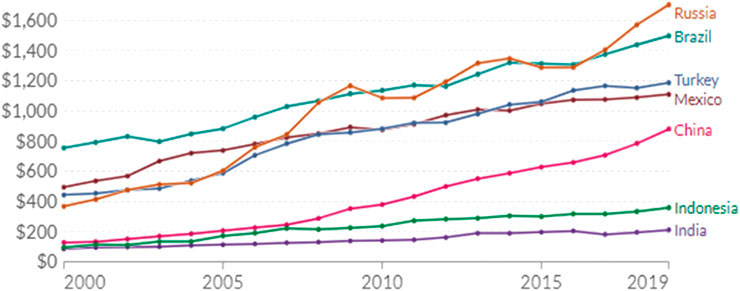
FIGURE 3. The amount of yearly public and private health expenditures per person measured in dollars. Source; authors estimation and OurWorldInData.org/financing-healthcare.
In this regard, health expenditure, education, economic growth and population in the E-7 bloc, “China, Russia, India, Mexico, Indonesia, Brazil, and Turkey”, have notable characteristics to play in comprehensive environmental sustainability. The E-7 region has the foremost records in environmental deterioration. China contributes the highest percentage of global CO2, accounting for approximately 28.75% of total CO2 emissions in 2019, while the other E-7 economies contribute about 18% of CO2 emissions in the given period, thus making the E-7 region responsible for 46.09% of global CO2 emissions in 2019 (BP, 2020). According to the (IEA), fourth of the world’s highest CO2 emitter countries, “China 9300 Mt, India 2200 Mt, Indonesia 496.4, Russia 1500 Mt, Mexico 446.0 Mt and Turkey 378.6 Mt respectively,” are part of this group. In 2018, they comprised 26 percent of the total the global GDP, 47% of the world’s population, and more than 40% of the energy consumed globally. Relatively few works have studied the association between CO2 emissions, HEX, EDU, ECG, and POP, in the aforesaid studies see for (Balaguer & Cantavella, 2018; Fareed et al., 2018, 2022; Li et al., 2021; Shah et al., 2021; I. Ullah et al., 2019, 2020).
This study makes three contributions to the academic research works. First, this research is one of the few that assesses the factors influencing health expenses, education, economic growth and population in E-7 bloc. Our findings will help policymakers develop and implement health and education strategies. The second contribution is concerned with the assortment of indicators in our study. Although there are several research in the literature on the link between health expenditure, education, economic growth and population, there are relatively few studies that incorporate factors, particularly for a sustainable environment in the E-7 region; this study adds to the current body of knowledge by giving actual evidence of the influence of health expenditure, education, economic growth, and population on CO2 emission regarding of the E-7 bloc. Nonetheless, the current literature investigated the aforementioned link. Still, the inconsistent findings reflect a hazy picture of the relationship in emerging countries. Hence, this study, on the other hand, provides a clear depiction of the relationship mentioned above in emerging economies. Finally, we use scientific and empirical methodologies to analyze the long-term dynamics of E-7. The study used the modern econometric techniques such as cross-sectional dependency test (Pesaran et al., 2004), second-generation panel unit-root (Pesaran, 2007) and second-generation cointegration tests (Westerlund, 2007), and for lung run estimation used PFMOLS and PDOLS techniques. This study also used AMG-CCEMG methods for robustness findings. The study’s outcomes are intended to lighten the relationships between HEX, EDU, ECG, and POP on environmental degradation. In order to accomplish high levels of health results across the nation, the policy suggestions based on scientific evidence will provide environmental health recommendations, implications for the use of physical fitness and physical education, and a more effective allocation of health expenditure.
The following portions are as follows: Section 2 describe synopsis of the previous research; Section 3 describes the methodology model; Section 4 presents the empirical findings and discussion; and Section 5 discusses the conclusion and implications for policy based on the empirical research outcomes.
2 Literature review
The relevant scientific studies can be grouped into three sub-categories: the affiliation between health expenditure and environmental deterioration, the relationship between physical education and environmental deterioration and the connection between economic growth and environmental deterioration.
2.1 The health expenditure and environmental deterioration (CO2)
The relationship between environmental deterioration and HEX has been examined in empirical studies using various instances and analytical approaches, with varied empirical conclusions. The CO2 emissions will have an adverse influence on the healthcare of individuals, hence affecting HEX. Considering the link between CO2 and healthcare expenditures, (I. Ullah et al., 2019) studied the causation between trade, HEX, and CO2 emissions in China from 1990 to 2017 by using a simultaneous equations model. Their outcomes showed that trade significantly effects on CO2 emissions and results in a rise in healthcare expenditure in the country. (Apergis et al., 2020) examined the long-run dynamics among environmental degradation and HEX in four economic groups using data from 1995 to 2017. According to the findings, HEX would rise by 2.5% for every 1% rise in CO2 emission. (I. Ullah et al., 2020) determined the drivers of healthcare expenditures in Pakistan during 1998–2017 by using 2SLS and 3SLS techniques. The empirical results showed that CO2 emissions boost health expenditure. (Shah et al., 2021) examined the impacts of CO2 and public expenditure on the atmosphere for life expectancy and utilized the ARDL technique for China from 1999 to 2017; the outcome revealed that life expectancy responds inversely to negative and positive tremors on sustainable environment. (Samah et al., 2020) analyzed the relation between HEX and environmental degradation for Malaysia under the influence of COVID-19 using the panel dataset with system GMM. According to estimates, rising HEX will boost CO2 emissions. Several studies (Zaidi & Saidi, 2018; Apergis et al., 2020; Shah et al., 2021), have demonstrated a positive correlation among HEX and pollution emissions. Khan et al. (2020), utilized GMM and FMOLS techniques to examine the influence of HEX on environmental pollution in BRI from 1995 to 2016 and discovered that a rise in health spending had a harmful influence on environmental quality. Similarly, (Zaman and Abd-el Moemen, 2017; Apergis et al., 2018) discovered that a rise in HEX had a detrimental impact on CO2 emissions. Few studies have examined the causal link among CO2 and HEX, such as recent research (Chaabouni and Saidi, 2017) also discovered a unidirectional causal link between CO2 and HEX. (Zaidi & Saidi, 2018) demonstrated a one-way causality from HEX to ECG and a bi-directional causal relation among HEX and CO2 emissions in SSA economies. (I. Ullah et al., 2020) In Pakistan, a dynamic simultaneous equation model was used to evaluate HEX, CO2 emissions, and ECG. The statistical evidence indicated the presence of two-way causation between CO2 emissions and ECG, as well as one-way causality between HEX and ECG.
2.2 The education and environmental deterioration
Aside from health expenditure, environmentalists focus these days on the environment’s response to society’s expanding level of education (Balaguer & Cantavella, 2018). Among other initiatives, increasing knowledge and understanding of environmental devastation through social exhortation and environmental education can be crucial in decreasing CO2 emissions and mitigating the detrimental impacts of global warming (Katircioglu et al., 2020). Education may play an essential part in teaching social responsibility in a society, which can aid in the reduction of pollution emissions. Although numerous elements connected to the primary drivers of CO2 are employed in the literature, the prospective impacts of EDU on environmental deterioration did not attract the researchers’ interest. There are various processes via which EDU might positively or negatively impact CO2. The recent research of (Sart et al., 2022), observed the relationship of economic freedom, education and CO2 in the context of EU members for 2000–2018, the causality analysis revealed that financial freedom and education can be favorable to mitigating environmental deterioration and increase environmental quality in the panel region. Similarly, the study of (Mehmood, 2022), utilized CS-ARDL for south Asian region for 1990–2020, and investigated that education expenditure will decrease the CO2 emissions in the south Asian area. (Liu et al., 2022) evaluated the links between financial inclusion, education and CO2, and using the ARDL approach, their outcomes showed that EDU could play a significant role in reducing CO2 emissions in China.
Similarly, according to (Zaman et al., 2021) the outcomes show the negative association between EDU and CO2 emissions for China and using ARDL and FMOLS techniques from 1991 to 20 indicates that EDU will help mitigate CO2 in China. In contrast (Katircioglu et al., 2020), EDU development, like other sectors such as FDI, and economic growth, may raise total energy demand and increase CO2 emissions. According to (Shields, 2019) there is a significant link between higher levels of education and worldwide climate shift. Consequently, the long-run effects of education cannot be disregarded, as it increases social and cultural awareness responsibility (Alkhateeb et al., 2020). (Subramaniam & Masron, 2020), examined the impact of education on the climate in 22 emerging nations from 1990 to 2016 using the ARDL method. They found that the significant impact of poverty on climate change can diminish after a specific level of educational accomplishment. Some new studies also examine the direct relationship between education and pollutant releases and environmental degradation (Shields, 2019; Zaman et al., 2021; Liu et al., 2022; Mehmood, 2022). Therefore, educational status, physical education and human resources contribute to reducing air pollutants and forming the EKC, since they promote renewable energy.
2.3 The economic growth and environmental deterioration
Many recent works have studied the connection between CO2 emission and ECG, but no consent has been expressed (Wang et al., 2022). For instance, the causal relationships between HEX, ECG, and CO2 emissions are examined by (Chaabouni and Saidi, 2017). Their Granger causality analyses revealed a substantial bidirectional causal relationship between these variables from 1960 to 2008. (Ali et al., 2021) investigate the link between numerous elements that generate CO2 and ECG in Vietnam and discovered that as Vietnam’s industrialization level increased, ECG was supported at the expense of using a massive amount of fossil fuels, which increased CO2. (Mongo et al., 2021) utilize the ARDL approach for fifteen European economies and the outcomes show that the result of ECG, economic openness and other indicators increase environmental degradation. Similarly, (Majeed et al., 2021) discovered that ECG significantly and positively influenced CO2 emissions in GCC countries from 1990 to 2018. ECG increases CO2 emissions in Asian countries, according to (Luo et al., 2021). Prior findings on the effects of ECG on the environment have often concentrated on the nexus ECG-CO2 emissions, utilizing the EKC hypothesis as a theoretical underpinning. However, the current study on the ECG-CO2 emissions relationship under the EKC hypothesis produced contradictory results. For instance, the EKC hypothesis has been authenticated by (Luo et al., 2021) for selected Asian economies, (Jianguo et al., 2022) for the OECD region, (Shah et al., 2021)and (I. Ullah et al., 2019) for China. (Ali et al., 2021) for Vietnam. Finally, several scholars have observed at the relationship between CO2, ECG and financial institutions (Khan et al., 2020), energy composition (Islam and Abdul Ghani, 2018), and quality of institutions (Wawrzyniak and Doryń, 2020).
3 Research design
The current work studied the impacts of health expenditure, education, economic growth and population on environmental deterioration in the E-7 bloc. The research performs the following approaches to scrutinize the effects of considered indicators (see details in Figure 4).
3.1 Model specification
In this work, we used the following dynamic panel regression model to link CO2 emissions to HEX, EDU, ECG, and POP indicators:
Where CO2 = represent the carbon dioxide emissions, i economies, t time, and α, β, δ are measured as the coefficient, and ε is the residual term. The coefficients β1, β2 … β11 represent the estimates of CO2, explanatory and control variables. HEX, health expenditure, EDU, education, ECG, economic growth, and POP, population.
3.2 Estimation methods
3.2.1 The cross-sectional dependence (CSD)
CSD arises when macroeconomic tremors have similar impacts on cross-sections within a panel; hence these cross-sections are CSD and can generate ambiguous results if not addressed (Jianguo et al., 2022). International accords, trade contracts, and economic and socio combination may cause cross-sectional interdependence in E-7 economies. As mentioned in Equation, the CSD test established by (Pesaran et al., 2004) was utilized to address this methodological challenge using panel data.
3.2.2 The panel unit root test
This is critical for ensuring stationarity since non-stationary series might generate deceptive findings. First-generation techniques, such as the, do not address CD concerns in datasets (Im et al., 2003). (Pesaran, 2007) introduced the CIPS and CADF second-generation panel unit root estimates to address the shortcomings of the first-generation method. This approach is expected to give dependable and consistent stationarity features in the existence of CD difficulties in the sample. The unit root equation is:
3.2.3 The panel cointegration test
Similar to first-generation panel unit root approaches, first-generation panel cointegration estimators do not consider CD issues. (Westerlund, 2007) A second-generation panel cointegration estimate was published to identify the cointegrating properties between the parameters in the presence of CD. The bootstrapped approach is used in this procedure to assess the standard errors of four statistical tests, which resolves the CSD: “Gt, GA, Pt, and Pa. Gt and Ga” are group-mean statistics that are calculated when the alternative hypothesis of cointegration between the variables in at least one cross-section is tested against the null hypothesis of non-cointegration. In contrast, a stringent alternative hypothesis of series cointegration in all cross-sections predicts the two panel-mean statistics Pt and Pa.
3.2.4 The long run estimation results
The Panel Dynamic PEMLOS and PDOLS are applied and used to estimate the model’s long-term coefficients. Some researchers claim that the PDOLS methodology not only helps assess robust results but also executes more reliably and produces enhanced characteristics of the respondents for small panel sizes (Luo et al., 2021). Furthermore, FMOLS and DOLS approaches solve the issue of heterogeneity and heterogeneous cointegration (Weimin et al., 2022). On the other hand, some researchers argue that the PFMOLS methodology is superior to the PDOLS technique since it addresses several data issues, such as simultaneity and autocorrelation, while also producing credible outcomes in smaller panel samples (Luo et al., 2021). As a result, in order to avoid any contradictions in the results, we use more than one econometric approach to produce more consistent results. The CO2 function for panel data is:
The following Eqn. 7 is advocated by Pedroni (2004) to compute the
Where
Additionally, Pedroni signified the following Eqn. 8 by counting lead, and lag features for PDOLS estimators.
To evaluation the coefficients of
Where
3.2.5 The AMG and CCEMG
This work will also use two further approaches, AMG and CCEMG, to test the reproducibility of the PFMOLS and PDOLS results. CSD, heterogeneity, cointegration breakdowns, and non-stationarity are all handled in both of these approaches (Luo et al., 2021). CCEMG and AMG use cross-sectional averages of both dependent and independent indicators.
4 Empirical results
4.1 Pre-regression statistics
The study analyzed to investigates the effect of HEX, ECG, EDU, and POP, on the CO2 emissions for the panel of E-7 from 2000 to 2019. Table 1 shows the descriptive statistics and correlation matrix for all factors included in this study. The descriptive statistics for all indicators reveal various Min-Max values for all parameters. Similarly, the correlation matrix displays the positive relation of HEX, ECG, and POP, while the negative correlation of education indicators with CO2 emissions.
Before examining the presence of the unit root and cointegration among the variables, it is required to explore the CSD among the sample nations. As a result, actions performed in one country may also impact another country. We used the Pesaran et al., 2004, Breusch and Pagan, 1980 technique to determine CSD among the E-7 economies. The findings in Table 2 corroborated the CD among the countries in the study, showing that any change in the amount of HEX, ECG, EDU, and POP in one country of E-7 might have an impact on the other E-7 country. Table 3 summarizes the findings of the (Hashem Pesaran and Yamagata, 2008) slope homogeneity test in the research, confirming that the model has a slope heterogeneity issue.The presence of CSD and SH in the data suggests that the indicators’ stationarity and long-run connection should be confirmed using second-generation unit root and cointegration. According to both the CIPS and CADF tests, the results in Table 4 demonstrate that all of the variables considered in the study are stationary at first difference I (1). As a consequence, to address the issues of CD and heterogeneity in the model, we employed the Westerlund Cointegration approach, and the findings shown in Table 5 demonstrate the (Westerlund-2007) Cointegration results in the presence of a long-run link between the variables in all three models at the 1% significant level.
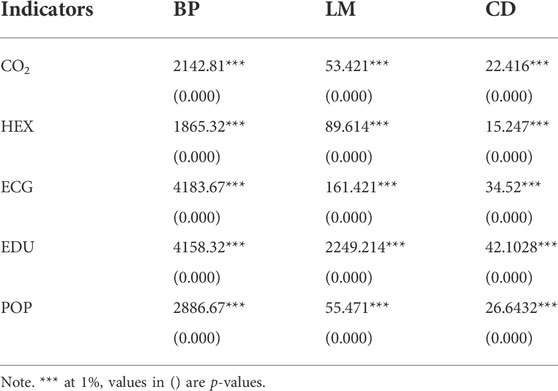
TABLE 2. The Pesaran et al., 2004 CSD test.
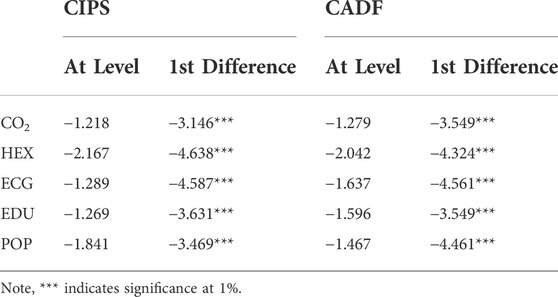
TABLE 4. The (Pesaran, 2007) Panel Unit-root test.
4.2 Regression results
After confirming the long-term association between the indicators, we used the PFMOLS and PDOLS tests to determine the variables’ long-term coefficients. Table 6 presents the analysis using PFMOLS and PDOLS estimations. The findings reveal that CO2 emissions have a positive and significant relationship with HEX. This result indicates that a 1% increase in CO2 emissions leads in a (PFMOLS 0.16324% and PDOLS 0.26314%) rise in HEX. There are two potential effects of HEX on CO2. The important policy is that the government aggressively regulates CO2 because pollution increases healthcare costs. Because the impact of health expenses is proportional to population expansion, an increase in energy consumption leads in increased pollution of the atmosphere (Chaabouni et al., 2016; Chaabouni and Saidi, 2017). On the other hand, HEX raises people’s awareness of pollution and reduces CO2. The first effect is far more significant than the second (Shah et al., 2021). The findings support the claims made by Khan (Mohmmed et al., 2019; I. Ullah et al., 2019, 2020) that boosting CO2 emissions raises health care costs.
In table 6, according to PFMOLS and PDOLS estimates, ECG increased CO2 emissions in sample nations by PFMOLS 0.42142% and PDOLS 0.54328%, respectively. ECG has been identified as one of the key drivers of the rise in CO2 emissions. As a result, it is realistic to conclude that, on average, chosen E-7 economies are on a sustainable path, in which greater ECG leads to enhanced CO2 emissions up to a certain point due to fast industrialization (Ali et al., 2021; Luo et al., 2021).
Third, the outcomes recommend that EDU has a favorable impact on environmental quality, The relationship of education and CO2 emission is favorable, its mean education increase the environmental quality in E-7 nations, results are consistent with recent findings (Balaguer & Cantavella, 2018). Our findings demonstrate that education alone, without an environmentally suitable curriculum, cannot reduce CO2 emissions. Adding environmental content to EDU, promoting awareness through the media, and offering energy efficiency training to the workforce are all viable policy choices for promoting the environmental advantages of education. To reap any benefit from education, a comprehensive set of environmental protection laws is required; otherwise, education would raise people’s purchasing power, energy usage, and, as a result, environmental damage. Education spending allows the majority of the population to comprehend their environment better. Citizens with greater awareness of the world are more likely to live sustainably. As a result, the outcomes of panel-level and country causality studies primarily corroborate theoretical predictions. Furthermore, the associated empirical research has typically indicated that education significantly impacts the environment (Balaguer & Cantavella, 2018; Li et al., 2021; Cui et al., 2022; Sart et al., 2022). As a result, education is one of the most important tools for improving environmental quality. Finally in table 6 findings show that, the sample nations, where a 1% rise in population growth resulted in PFMLOS 0.63471% and PDOLS 0.36489% increase CO2 emissions, as assessed by PFMOLS and PDOLS, respectively. Population expansion has been identified as the primary cause of rising CO2 emissions, raising energy consumption (Luo et al., 2021). A large body of evidence confirms the positive relationship between population and CO2 emissions (Luo et al., 2021), and this is notably true in the context of E-7 countries, given their huge percentage of the global population. The population’s position as a CO2 augmenting factor may be seen from various perspectives. Higher use of resources, such as energy, fossil fuels, transportation, and other products and services, results in more significant CO2 emissions as the population grows.
4.3 Robustness tests
Tables 7 show the results of the CCEMG and AMG tests, respectively. The CCEMG and AMG findings in Table 7 are identical to those obtained using PFMOLS and PDOLS in Table 6, confirming the consistency of our results. The CCEMG and AMG results also indicated the importance of the overall model, as the Wald test value was significant. Similarly, the Root Mean Square Error (RMSE) for both tests is approximately identical; however, the RMSE number for CCEMG is higher than that of the AMG model. However, (Luo et al., 2021) highlighted whether the tests CCEMG and AMG have a unit root problem, CSD, and cointegration or not.
5 Conclusion and policy suggestions
The effects of environmental quality are significantly mitigated by physical activity, education and health care systems. This study adds to the body of knowledge about the dynamic link between CO2 emissions, healthcare expenditure, economic development, education, and population for the E-7 countries between 2000 and 2019. The CSD test was used to investigate cross-sectional dependence, CIPS and CADF tests to determine variable integration order, Westerlund cointegration test to validate variable cointegration, and PFMOLS and PDOLS to provide long-run coefficients of parameter estimates and also used AMG and CCEMG techniques for robustness checks. PFMOLS and PDOLS showed that education had a negative and substantial effect on CO2 emissions in E-7, whereas health spending, economic growth, and population increase had a positive and significant influence. CO2 emissions have severe repercussions for environmental quality and environmental health, resulting in health-related concerns and increased healthcare costs at both the individual and public levels. The outcomes of our study are validated and robust by applying AMG and CCEMG tests. As a result, the findings of this study are beneficial for E-7 nations in revising their policies to improve environmental quality.
Our paper makes recommendations for reducing CO2 emissions and increasing environmental quality in E-7 economies based on the research findings. Government law for CO2 control might be an acceptable instrument, and the government could reduce CO2 emissions to a desirable level, particularly in the exporting industry, balancing healthcare costs and CO2 emissions in the economy. Additionally, regulatory framework for CO2 control may be a useful instrument. The government may reduce CO2 emissions to the desired level, particularly in the exporting sector, which will balance healthcare costs and CO2 emissions in the economy. Education may efficiently address environmental deterioration by using market-based environmental instruments, promoting environmental awareness, physical education, and producing green or energy-efficient technology. The econometric findings provide recommendations for environmental quality, physical education and a more efficient allocation of health spending to attain excellent health outcomes in the region. Education expenditure is ecologically friendly, hence more investments should be made in this area.
The research has some limitations since it only considers one component of a rise in HEX caused by CO2 emissions using a case study of an emerging seven bloc, which may be expanded to other regions such as G-7, MENA, BRICS, etc. Both theoretical and empirical models may extend further to other factors, like life expectancy. Although the current study has significant outcomes, future research should be done using diverse environmental sustainability parameters, such as urbanization, financial development, trade, globalization, and industrialization, etc. This study employed CO2 as a proxy for environmental deterioration; future research should use different proxies.
Data availability statement
The raw data supporting the conclusions of this article will be made available by the authors, without undue reservation.
Author contributions
JB: conceptualization; supervision; writing—original draft preparation and editing. KA: conceptualization; formal analysis; validation; methodology; review and editing.
Conflict of interest
The authors declare that the research was conducted in the absence of any commercial or financial relationships that could be construed as a potential conflict of interest.
Publisher’s note
All claims expressed in this article are solely those of the authors and do not necessarily represent those of their affiliated organizations, or those of the publisher, the editors and the reviewers. Any product that may be evaluated in this article, or claim that may be made by its manufacturer, is not guaranteed or endorsed by the publisher.
References
Ali, K., Bakhsh, S., Ullah, S., Ullah, A., and Ullah, S. (2021). Industrial growth and CO2 emissions in Vietnam: The key role of financial development and fossil fuel consumption. Environ. Sci. Pollut. Res. 28 (6), 7515–7527. doi:10.1007/s11356-020-10996-6
Alkhateeb, T. T. Y., Mahmood, H., Altamimi, N. N., and Furqan, M. (2020). Role of education and economic growth on the CO2 emissions in Saudi Arabia. Entrepreneursh. Sustain. Issues 8 (2), 195–209. doi:10.9770/jesi.2020.8.2(12
Apergis, N., ben Jebli, M., and ben Youssef, S. (2018). Does renewable energy consumption and health expenditures decrease carbon dioxide emissions? Evidence for sub-saharan africa countries. Renew. Energy 127, 1011–1016. doi:10.1016/J.RENENE.2018.05.043
Apergis, N., Bhattacharya, M., and Hadhri, W. (2020). Health care expenditure and environmental pollution: A cross-country comparison across different income groups. Environ. Sci. Pollut. Res. 27 (8), 8142–8156. doi:10.1007/s11356-019-07457-0
Balaguer, J., and Cantavella, M. (2018). The role of education in the Environmental Kuznets Curve. Evidence from Australian data. Energy Econ. 70, 289–296. doi:10.1016/J.ENECO.2018.01.021
Breusch, T. S., and Pagan, A. R. (1980). The Lagrange multiplier test and its applications to model specification in econometrics. Rev. Econ. Stud. 47 (1), 239. doi:10.2307/2297111
Chaabouni, S., and Saidi, K. (2017). The dynamic links between carbon dioxide (CO2) emissions, health spending and GDP growth: A case study for 51 countries. Environ. Res. 158, 137–144. doi:10.1016/J.ENVRES.2017.05.041
Chaabouni, S., Zghidi, N., and ben Mbarek, M. (2016). On the causal dynamics between CO2 emissions, health expenditures and economic growth. Sustain. Cities Soc. 22, 184–191. doi:10.1016/J.SCS.2016.02.001
Cui, Y., Wei, Z., Xue, Q., and Sohail, S. (2022). Educational attainment and environmental kuznets curve in China: An aggregate and disaggregate analysis. Environ. Sci. Pollut. Res. 29 (30), 45612–45622. doi:10.1007/s11356-022-19051-y
Fareed, Z., Iqbal, N., Shahzad, F., Shah, S. G. M., Zulfiqar, B., Shahzad, K., et al. (2020). Co-variance nexus between COVID-19 mortality, humidity, and air quality index in Wuhan, China: New insights from partial and multiple wavelet coherence. Air Qual. Atmos. Health 13 (6), 673–682. doi:10.1007/s11869-020-00847-1
Fareed, Z., Meo, M. S., Zulfiqar, B., Shahzad, F., and Wang, N. (2018). Nexus of tourism, terrorism, and economic growth in Thailand: New evidence from asymmetric ARDL cointegration approach. Asia Pac. J. Tour. Res. 23 (12), 1129–1141. doi:10.1080/10941665.2018.1528289
Fareed, Z., Rehman, M. A., Adebayo, T. S., Wang, Y., Ahmad, M., and Shahzad, F. (2022). Financial inclusion and the environmental deterioration in Eurozone: The moderating role of innovation activity. Technol. Soc. 69, 101961. doi:10.1016/J.TECHSOC.2022.101961
Hashem Pesaran, M., and Yamagata, T. (2008). Testing slope homogeneity in large panels. J. Econ. 142 (1), 50–93. doi:10.1016/J.JECONOM.2007.05.010
Im, K. S., Pesaran, M. H., and Shin, Y. (2003). Testing for unit roots in heterogeneous panels. J. Econ. 115 (1), 53–74. doi:10.1016/S0304-4076(03)00092-7
Islam, R., and Abdul Ghani, A. B. (2018). Link among energy consumption, carbon dioxide emission, economic growth, population, poverty, and forest area: Evidence from ASEAN country. Int. J. Soc. Econ. 45 (2), 275–285. doi:10.1108/IJSE-12-2016-0351
Jahanger, A., Usman, M., and Ahmad, P. (2022). A step towards sustainable path: The effect of globalization on China’s carbon productivity from panel threshold approach. Environ. Sci. Pollut. Res. 29 (6), 8353–8368. doi:10.1007/s11356-021-16317-9
Jianguo, D., Ali, K., Alnori, F., and Ullah, S. (2022). The nexus of financial development, technological innovation, institutional quality, and environmental quality: Evidence from OECD economies. Environ. Sci. Pollut. Res. 29 (38), 58179–58200. doi:10.1007/s11356-022-19763-1
Katircioglu, S., Katircioĝlu, S., and Saqib, N. (2020). Does higher education system moderate energy consumption and climate change nexus? Evidence from a small island. Air Qual. Atmos. Health 13 (2), 153–160. doi:10.1007/s11869-019-00778-6
Khan, A., Hussain, J., Bano, S., and Chenggang, Y. (2020). The repercussions of foreign direct investment, renewable energy and health expenditure on environmental decay? An econometric analysis of B&RI countries. J. Environ. Plan. Manag. 63 (11), 1965–1986. doi:10.1080/09640568.2019.1692796
Li, H., Khattak, S. I., and Ahmad, M. (2021). Measuring the impact of higher education on environmental pollution: New evidence from thirty provinces in China. Environ. Ecol. Stat. 28 (1), 187–217. doi:10.1007/s10651-020-00480-2
Liu, N., Hong, C., and Sohail, M. T. (2022). Does financial inclusion and education limit CO2 emissions in China? A new perspective. Environ. Sci. Pollut. Res. 29 (13), 18452–18459. doi:10.1007/s11356-021-17032-1
Luo, R., Ullah, S., and Ali, K. (2021). Pathway towards sustainability in selected asian countries: Influence of green investment, technology innovations, and economic growth on CO2 emission. Sustainability 13 (22), 12873. doi:10.3390/su132212873
Majeed, A., Wang, L., Zhang, X., Muniba, , and Kirikkaleli, D. (2021). Modeling the dynamic links among natural resources, economic globalization, disaggregated energy consumption, and environmental quality: Fresh evidence from GCC economies. Resour. Policy 73, 102204. doi:10.1016/J.RESOURPOL.2021.102204
McMichael, A. J., Woodruff, R. E., and Hales, S. (2006). Climate change and human health: Present and future risks. Lancet 367 (9513), 859–869. doi:10.1016/S0140-6736(06)68079-3
Mehmood, U. (2022). Investigating the linkages of female employer, education expenditures, renewable energy, and CO2 emissions: Application of CS-ARDL. Environ. Sci. Pollut. Res. 29, 61277–61282. doi:10.1007/s11356-022-20275-1
Mohmmed, A., Li, Z., Olushola Arowolo, A., Su, H., Deng, X., Najmuddin, O., et al. (2019). Driving factors of CO2 emissions and nexus with economic growth, development and human health in the Top Ten emitting countries. Resour. Conservation Recycl. 148, 157–169. doi:10.1016/J.RESCONREC.2019.03.048
Mongo, M., Belaïd, F., and Ramdani, B. (2021). The effects of environmental innovations on CO2 emissions: Empirical evidence from Europe. Environ. Sci. Policy 118, 1–9. doi:10.1016/J.ENVSCI.2020.12.004
Pedroni, P. (2004). Panel cointegration: Asymptotic and finite sample properties of pooled time series tests with an application to the ppp hypothesis. Econ. Theory 20 (3), 597–625. doi:10.1017/S0266466604203073
Pesaran, M. H. (2007). A simple panel unit root test in the presence of cross-section dependence. J. Appl. Econ. Chichester. Engl. 22 (2), 265–312. doi:10.1002/jae.951
Pesaran, M. H., Schuermann, T., and Weiner, S. M. (2004). Modeling regional interdependencies using a global error-correcting macroeconometric model. J. Bus. Econ. Statistics 22 (2), 129–162. doi:10.1198/073500104000000019
International Renewable Energy Agency (2021). World energy transitions outlook 1.5°C pathway. Available at: www.irena.org.
Samah, I. H. A., Rashid, I. M. A., Husain, W. A. F. W., Ibrahim, S., Hamzah, H., and Amlus, M. H. (2020). The impact of healthcare expenditure and healthcare sector growth on Co2 emission using dynamic panel data system gmm estimation model during covid 19 crisis. Int. J. Energy Econ. Policy 10 (6), 235–241. doi:10.32479/ijeep.9769
Sart, G., Bayar, Y., Danilina, M., and Sezgin, F. H. (2022). Economic freedom, education and CO2 emissions: A causality analysis for EU member states. Int. J. Environ. Res. Public Health 19 (13), 8061. doi:10.3390/ijerph19138061
Shah, M. H., Wang, N., Ullah, I., Akbar, A., Khan, K., and Bah, K. (2021). Does environment quality and public spending on environment promote life expectancy in China? Evidence from a nonlinear autoregressive distributed lag approach. Int. J. Health Plann. Manage. 36 (2), 545–560. doi:10.1002/hpm.3100
Shields, R. (2019). The sustainability of international higher education: Student mobility and global climate change. J. Clean. Prod. 217, 594–602. doi:10.1016/j.jclepro.2019.01.291
Subramaniam, Y., and Masron, T. A. (2020). Education, methane emission and poverty in developing countries. J. Environ. Econ. Policy 9 (3), 355–369. doi:10.1080/21606544.2019.1689175
Ullah, I., Ali, S., Shah, M. H., Yasim, F., Rehman, A., and Al-Ghazali, B. M. (2019). Linkages between trade, CO2 emissions and healthcare spending in China. Int. J. Environ. Res. Public Health 16 (21), 4298. doi:10.3390/ijerph16214298
Ullah, I., Rehman, A., Khan, F. U., Shah, M. H., and Khan, F. (2020). Nexus between trade, CO 2 emissions, renewable energy, and health expenditure in Pakistan. Int. J. Health Plann. Manage. 35 (4), 818–831. doi:10.1002/hpm.2912
Ullah, S., Nadeem, M., Ali, K., and Abbas, Q. (2022). Fossil fuel, industrial growth and inward FDI impact on CO 2 emissions in Vietnam: Testing the EKC hypothesis. Manag. Environ. Qual. Int. J. 33 (2), 222–240. doi:10.1108/MEQ-03-2021-0051
Usman, M., Jahanger, A., Makhdum, M. S. A., Balsalobre-Lorente, D., and Bashir, A. (2022). How do financial development, energy consumption, natural resources, and globalization affect arctic countries’ economic growth and environmental quality? An advanced panel data simulation. Energy 241, 122515. doi:10.1016/J.ENERGY.2021.122515
Wang, C.-M., Hsueh, H.-P., Li, F., and Wu, C.-F. (2019). Bootstrap ARDL on health expenditure, CO2 emissions, and GDP growth relationship for 18 OECD countries. Front. Public Health 7, 324. doi:10.3389/fpubh.2019.00324
Wang, N., Ullah, A., Lin, X., Zhang, T., and Mao, J. (2022). Dynamic influence of urbanization on inclusive green growth in belt and road countries: The moderating role of governance. Sustainability 14 (18), 11623. doi:10.3390/su141811623
Wang, Z., Asghar, M. M., Zaidi, S. A. H., and Wang, B. (2019). Dynamic linkages among CO2 emissions, health expenditures, and economic growth: Empirical evidence from Pakistan. Environ. Sci. Pollut. Res. 26 (15), 15285–15299. doi:10.1007/s11356-019-04876-x
Wawrzyniak, D., and Doryń, W. (2020). Does the quality of institutions modify the economic growth-carbon dioxide emissions nexus? Evidence from a group of emerging and developing countries. Econ. Res.-Ekon. Istraz. 33 (1), 124–144. doi:10.1080/1331677X.2019.1708770
Weimin, Z., Chishti, M. Z., Rehman, A., and Ahmad, M. (2022). A pathway toward future sustainability: Assessing the influence of innovation shocks on CO2 emissions in developing economies. Environ. Dev. Sustain. 24 (4), 4786–4809. doi:10.1007/s10668-021-01634-3
Westerlund, J. (2007). Testing for error correction in panel data. Oxf. Bull. Econ. Stat. 69 (6), 709–748. doi:10.1111/j.1468-0084.2007.00477.x
Yang, B., Jahanger, A., and Khan, M. A. (2020). Does the inflow of remittances and energy consumption increase CO2 emissions in the era of globalization? A global perspective. Air Qual. Atmos. Health 13 (11), 1313–1328. doi:10.1007/s11869-020-00885-9
Zaidi, S., and Saidi, K. (2018). Environmental pollution, health expenditure and economic growth in the Sub-Saharan Africa countries: Panel ARDL approach. Sustain. Cities Soc. 41, 833–840. doi:10.1016/J.SCS.2018.04.034
Zaman, K., and Abd-el Moemen, M. (2017). The influence of electricity production, permanent cropland, high technology exports, and health expenditures on air pollution in Latin America and the Caribbean Countries. Renew. Sustain. Energy Rev. 76, 1004–1010. doi:10.1016/J.RSER.2017.03.103
Keywords: CO2 emissions, health expenditure, education, economic growth, PFMLOS, PDOLS
Citation: Bu J and Ali K (2022) Environmental degradation in terms of health expenditure, education and economic growth. Evidence of novel approach. Front. Environ. Sci. 10:1046213. doi: 10.3389/fenvs.2022.1046213
Received: 16 September 2022; Accepted: 04 October 2022;
Published: 19 October 2022.
Edited by:
Zeeshan Fareed, Huzhou University, ChinaReviewed by:
Karamat Khan, Henan University, ChinaChen Pinglu, Huazhong University of Science and Technology, China
Copyright © 2022 Bu and Ali. This is an open-access article distributed under the terms of the Creative Commons Attribution License (CC BY). The use, distribution or reproduction in other forums is permitted, provided the original author(s) and the copyright owner(s) are credited and that the original publication in this journal is cited, in accordance with accepted academic practice. No use, distribution or reproduction is permitted which does not comply with these terms.
*Correspondence: Junqin Bu, YjQ5ODkyODIxNUB5ZWFoLm5ldA==; Kishwar Ali, a2lzaHdhcmFsaUB1anMuZWR1LmNu, a2lzaHdhcmFsaUBzdHUuenVlbC5lZHUuY24=
 Junqin Bu1*
Junqin Bu1* Kishwar Ali
Kishwar Ali
